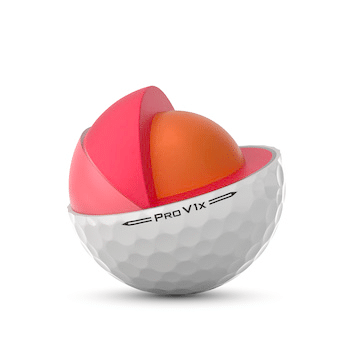Golf ball manufacturers have put a ton of research and development into making their golf balls. So much so, that the performance differences from one ball to the next are relatively small.
Understanding how they are made and more specifically, the performance characteristics of each will help you decide which golf ball is best for your game.
I have been studying golf balls for the last couple of years, including my own personal testing with a launch monitor. I’ve hit tens of thousands, recording data from each shot. Cutting them open, checking for consistency, and just anything related to golf balls I can think of.
One thing that is very clear is – picking the wrong ball can absolutely affect your game. You can lose distance off the tee, or miss out on some greenside spin control.
What are all of these “x” piece golf balls?

I’m sure you’ve heard “two-piece golf ball”, or “three-piece golf ball”…maybe even “four-piece golf balls”. So aside from the obvious, what’s the real difference? Well, it really comes down to performance!
You may also be surprised to learn that golf balls may have single, double, or even triple covers.
Generally, the “X” version of golf balls will have more than 3 layers and more than 1 cover. The ProV1X for example.
Two Piece Golf Balls
Two-piece golf balls will generally produce less spin and are built to maximize distance. Less spin off the tee equals more distance. But, this reduced spin also translates to less greenside control. They just don’t spin as much with your wedges!
One of the most popular two-piece golf balls on the market is the Callaway Supersoft.
Related – Callaway Supersoft Golf Balls Review
A two piece golf ball only has a thin cover and a solid rubber core. The “rubber” that makes up the core, is a combination of materials that is usually proprietary to each manufacturer. Generally, resins and even trace amounts of heavy metals can be found in the core of golf balls.
Three Piece Golf Balls
Three-piece golf balls will generally give you the best of both worlds. They are built to do both – maximize distance off the tee, and offer great greenside spin.
They achieve this by having a core that will help produce distance, a mantle layer that helps reduce spin off the tee, and a soft outer cover that will grip your irons and produce greenside spin.
The best 3-piece golf ball on the market, and the ball I play regularly is the Vice Pro. The most popular three-piece golf ball on the market is the Titleist ProV1.
Related – Vice Pro vs. ProV1
A three-piece golf ball has a core, a mantle layer, and an outer cover.
Four Piece Golf Balls
Four-piece golf balls also aim to give you the best of both worlds – meaning distance off the tee and greenside control.
Honestly, I don’t think they actually deliver any better than 3-piece golf balls.
A four-piece golf ball has – you guessed it, 4 pieces that include a core, an outer core layer, a mantle layer, and a cover.
One of the most popular 4-piece golf balls on the market is the Chrome Soft X. Note the “X”…the original Chrome Soft, and current, is a 3-piece golf ball.
Five Piece Golf Balls
Yes, it’s getting a bit ridiculous. I feel like I am seeing the old razor races with “3 blades”, “4 blades”, “5 blades”.
Just like their 4-piece and 3-piece counterparts, they offer the best of both worlds in distance off the tee and greenside control.
A five-piece ball has an inner core and 3 layers between the core and the outer cover. Each layer has its own purpose, at least that’s what the manufacturer wants you to believe.
Honestly, the performance difference is basically nothing. Once you get to a 3-piece golf ball, you’ll achieve all the performance benefits that exist with today’s technology.
One of the most popular 5-piece golf balls on the market is the TP5.
Golf Ball Construction Chart
Here is a chart on some of the most popular golf ball manufacturers. For a full list, you can reference the USGA conforming ball list.
| Manufacturer | Golf Ball | Pieces | Cover |
| Titleist | ProV1 | 3 | Single |
| Titleist | Tour Speed | 3 | Single |
| Titleist | Velocity | 2 | Single |
| Titleist | TruFeel | 2 | Single |
| Titleist | AVX | 3 | Single |
| Titleist | ProV1X | 4 | Single |
| Taylormade | Tour Response | 3 | Single |
| Taylormade | TP5 | 5 | Single |
| Taylormade | TP5X | 5 | Single |
| Taylormade | Soft Response | 3 | Single |
| Taylormade | Distance Plus | 2 | Single |
| Callaway | ERC | 3 | Single |
| Callaway | Chrome Soft | 3 | Single |
| Callaway | Chrome Soft X | 4 | Single |
| Callaway | Chrome Soft X LS | 4 | Single |
| Callaway | SuperFast | 2 | Single |
| Callaway | SuperSoft | 2 | Single |
| Callaway | Warbird | 2 | Single |
| Bridgestone | e12 | 3 | Double |
| Bridgestone | e6 | 2 | Single |
| Bridgestone | e9 Long Drive | 2 | Single |
| Bridgestone | Tour B RX | 3 | Double |
| Bridgestone | Tour B RXS | 3 | Double |
| Bridgestone | Tour B X | 3 | Double |
| Bridgestone | Tour B XS | 3 | Double |
| Vice | Drive | 2 | Single |
| Vice | Pro | 3 | Double |
| Vice | Pro Plus | 4 | Triple |
| Vice | Pro Soft | 3 | Double |
| Vice | Pro Zero | 3 | Single |
| Vice | Tour | 3 | Double |
| PXG | PXG | 3 | Single |
| Snell | MTB-X | 3 | Single |
| Snell | MTB-Black | 3 | Single |
| Srixon | Z Star | 3 | Single |
| Srixon | Z Star XV | 4 | Single |
| Srixon | Soft Feel | 2 | Single |
| Srixon | Q-Star | 3 | Single |
| Srixon | Trispeed Tour | 3 | Single |
| Srixon | Distance | 2 | Single |
| Mizuno | RB 566 | 2 | Single |
| Mizuno | RB 566 V | 3 | Double |
| Mizuno | RB Tour X | 4 | Double |
| Mizuno | RB Max | 3 | Single |
| Mizuno | Nexdrive | 2 | Single |
Golf Ball Manufacturers
Most manufacturers aim to produce golf balls that meet the needs of all golfers. From the once or twice-a-year golfer to the Tour Professional players.
Titleist for example, has the TruFeel, which is a less expensive option for casual golfers. It is a 2-piece golf ball and is priced accordingly.
Then, there is the ProV1, which is the mac-daddy of premium golf balls.
Then, in between, you have a host of other options including the Velocity, Tour Soft, Tour Speed, and AVX. Each offers slightly different performance characteristics.
Some are built to produce more speed to assist golfers with lower swing speeds. Some are built to have a higher trajectory to produce more distance. Some are built to have a lower trajectory for a more penetrating flight pattern.
Golf Ball Covers

Believe it or not, golf balls can have a single or double cover. Many of the Bridgestone, Mizuno, Maxfli, Volvik, Vice, and even some Wilson golf balls have a double cover.
Cover material is typically urethane, surlyn, Ionomer, or trionomer. These are all simply polymers. Surlyn is a DuPont-branded material that is found on many golf balls. It is durable and soft enough to meet the needs of many manufacturers.
From a performance perspective, golf ball covers are important for feel, spin, and aerodynamics. A firmer cover will generally spin less off of your wedges. And the dimple pattern on the golf ball will help with aerodynamics and ensure the ball flight is consistent.
Golf Ball Core
Golf ball technology has come a long way over the last couple of decades. Gone are the days of wound golf balls, which were basically a bunch of rubber thread wound tightly, some even having a liquid center.
There are solid cores inside golf balls today. Made from composite materials and rubber. Each manufacturer has its own proprietary blend of materials to produce the exact firmness and bounce they desire from their particular ball.

Final Thoughts
Golf ball construction can absolutely impact overall ball performance. In general, two-piece golf balls will have good distance off the tee, but lack short-game control.
Three-piece golf balls generally offer both distance off the tee and have good short-game control.
You’ll pay for the extra performance, however. When selecting a golf ball, it’s important to take all of these factors into consideration. Some players won’t miss the extra greenside control one bit.
There are also plenty of high quality golf balls on the market that perform just as well as the higher-end premium golf ball manufacturers. Check out our golf ball selector tool to help you find the best ball for your game.
Good luck on the golf course.
